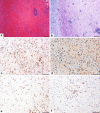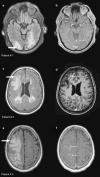Pathology of immune reconstitution inflammatory syndrome in multiple sclerosis with natalizumab-associated progressive multifocal leukoencephalopathy
- PMID: 22057786
- PMCID: PMC3259335
- DOI: 10.1007/s00401-011-0900-5
Pathology of immune reconstitution inflammatory syndrome in multiple sclerosis with natalizumab-associated progressive multifocal leukoencephalopathy
Abstract
Natalizumab is an approved medication for highly active multiple sclerosis (MS). Progressive multifocal leukoencephalopathy (PML) may occur as a severe side effect of this drug. Here, we describe pathological and radiological characteristics of immune reconstitution inflammatory syndrome (IRIS), which occurs in natalizumab-associated PML after the cessation of therapy, and we differentiate it from ongoing PML. Brain biopsy tissue and MRI scans from five MS patients with natalizumab-associated PML were analyzed and their histology compared with non-MS PML. Histology showed an extensive CD8-dominated T cell infiltrate and numerous macrophages within lesions, and in nondemyelinated white and grey matter, in four out of five cases. Few or no virally infected cells were found. This was indicative of IRIS as known from HIV patients with PML. Outstandingly high numbers of plasma cells were present as compared to non-MS PML and typical MS lesions. MRI was compatible with IRIS, revealing enlarging lesions with a band-like or speckled contrast enhancement either at the lesion edge or within lesions. Only the fifth patient showed typical PML pathology, with low inflammation and high numbers of virally infected cells. This patient showed a similar interval between drug withdrawal and biopsy (3.5 months) to the rest of the cohort (range 2.5-4 months). MRI could not differentiate between PML-associated IRIS and ongoing PML. We describe in detail the histopathology of IRIS in natalizumab-associated PML. PML-IRIS, ongoing PML infection, and MS exacerbation may be impossible to discern clinically alone. MRI may provide some clues for distinguishing different pathologies that can be differentiated histologically. In our individual cases, biopsy helped to clarify diagnoses in natalizumab-associated PML.
Figures





References
-
- Du Pasquier RA, Kuroda MJ, Zheng Y, Jean-Jacques J, Letvin NL, Koralnik IJ. A prospective study demonstrates an association between JC virus-specific cytotoxic T lymphocytes and the early control of progressive multifocal leukoencephalopathy. Brain. 2004;127:1970–1978. doi: 10.1093/brain/awh215. - DOI - PubMed
Publication types
MeSH terms
Substances
LinkOut - more resources
Full Text Sources
Medical
Research Materials

